Your kitchen contains the biggest energy and water hogs in your home. With all the resources in use in this popular room, there are many ways for energy to be used inefficiently. Luckily, changing a few cooking habits and using your appliances more efficiently can help you reduce your kitchen energy usage and save some cash.
Consider these kitchen energy-saving tips to use your appliances more efficiently and reduce the cost of your bills.
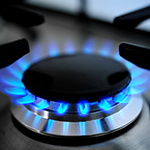
Keep Oven and Stove Heat Where It Belongs
When using the oven, preheat for 5-8 minutes only, and cut cooking time up to 20% by moving the rack closer to the heating unit. Every time you open the oven door, you lose 25-30 degrees, so check the food with the oven light instead. Save energy and time by using the self-cleaning feature right after cooking to take advantage of residual heat.
For smaller meals, cut usage in half with an electric pan or toaster oven. Slow cookers are a great alternative and average a dime’s worth of electricity per meal. Cut out electricity altogether by grilling outside, and you’ll avoid forcing the refrigerator to work harder in a hot kitchen.
If you have a gas range, confirm you are getting a blue flame. A yellow flame means the fuel is burning inefficiently, and your gas line should be checked by your gas company. When buying new, look for an oven with an automatic electric ignition system instead of having a continuously burning pilot light.
On top, purchase reflective (instead of dull) burner pans to direct more heat to cookware and save one-third of the energy usage. Blackened, dirty burner pans absorb heat and reduce efficiency, so clean them regularly. Reduce heat loss by using pots and pans with flat bottoms and matching them to the correct burner size.
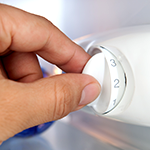
Avoid Overworking Your Refrigerator and Freezer
Another energy-saving tip is to not set your refrigerator and freezer colder than necessary. The Department of Energy recommends setting refrigerators between 36-40°F and freezers between -5-0°F.
You can do simple things to prevent your refrigerator from working overtime. Maintain circulation by not overcrowding the shelves. Make the condenser work more efficiently by waiting for food to cool before storing and covering containers to prevent moisture. Every three months, vacuum the condenser coils underneath and behind the unit. Test for air leakage by closing the door over a piece of paper. If you can pull the paper out easily, look into getting a new latch or seal.
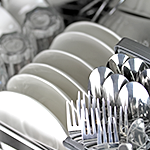
Reduce Water Usage
Conventional faucets flow up to five gallons per minute, but you can reduce this to 1.5 gallons simply by installing a low-flow faucet. Remember to choose cold water for rinsing, filling pots or running the garbage disposal. In fact, skip the garbage disposal and create a compost heap instead.
Dishwashers save time, but they raise utility bills, too. Wait until you have a full load and let dishes air dry after cleaning. The “rinse hold” setting uses 3-7 gallons of hot water per use, so ignore this setting when you only have a few soiled dishes. When purchasing a dishwasher, look for options with internal booster heaters, so that you can set your water heater thermostat at 120°F (rather than 140°F for dishwashing purposes).
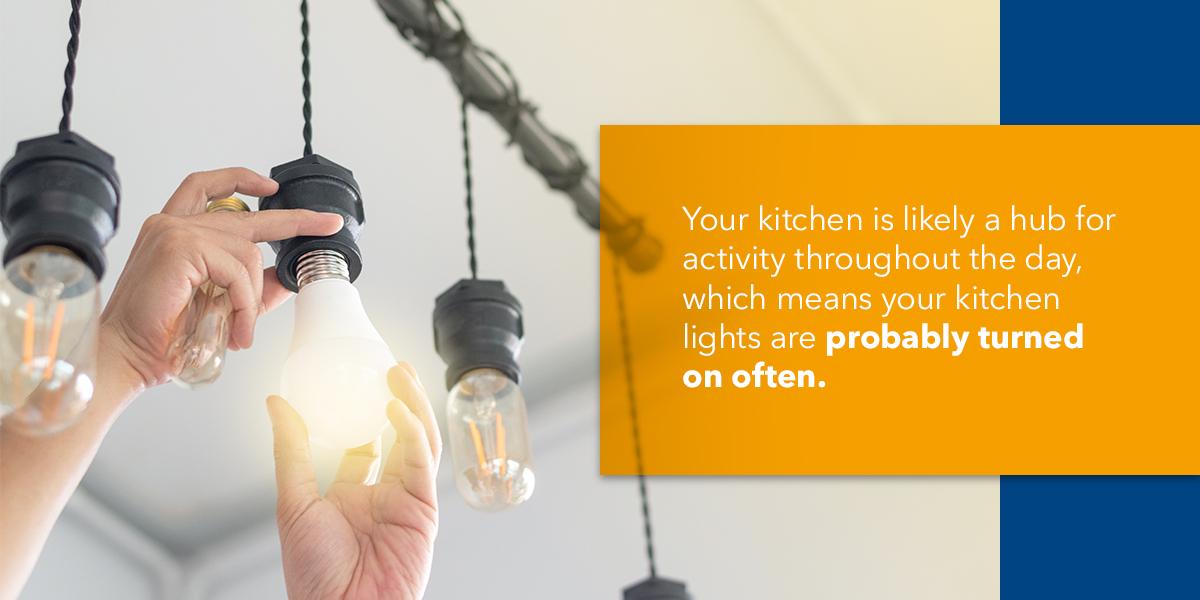
Use Energy Efficient Light Bulbs
Your kitchen is likely a hub for activity throughout the day, which means your kitchen lights are probably turned on often. Traditional light bulbs can burn a lot of unnecessary energy, especially if you have these lights turned on more than others. Consider replacing your light bulbs with a more energy-efficient option. For example, LED bulbs last longer and use about 90% less energy than traditional light bulbs.
Setting your kitchen lights on timers or dimmers can also help reduce energy use. Timers automatically turn your lights off after a specified amount of time, which can be especially helpful for families who leave lights on due to forgetfulness. Dimmers allow you to lower the light levels so you’re using less electricity than powering them at full capacity.
Install Window Film
While all these energy tips can help you cut back on energy use, one of the longest-lasting changes you can make is installing window films.
Your windows can significantly impact your energy consumption, especially when it comes to heating and cooling your house. In the winter, heat can escape through your windows, and the same can happen to the cool air from your air conditioning in the summer. Install window films to help keep your house warm in the winter and cool in the summer. With window films, your heating and air conditioning systems can run more efficiently, thus saving energy and money.
Find a Madico Window Film Dealer
Without making major changes, you can make your kitchen more energy efficient and save considerably on your monthly costs. Window films from Madico®, Inc. can help increase your home energy savings year-round while also providing a number of additional benefits, like:
- Glare control: Windows let in a lot of sunlight, which can create glare on your television and other devices. Reduce the annoying glare that makes it difficult to see your screens with Madico solar control film.
- Aesthetics: Madico window films are as functional as they are aesthetically pleasing. We create our films in a variety of hues and shades so you can find a film that adds to the look of your house.
- Fade prevention: As the sun shines through your windows, the UV rays can damage your furniture, flooring and other upholstery. After a while, they’ll fade and look worn. Madico window films help to block out harmful UV rays and preserve your belongings.
- Skin protection: Our window films can also help protect your skin. Sunlight can still damage your skin through windows, so window film provides an extra layer of UV protection.
Find a Madico window film dealer to start reducing your energy consumption today!


 1. Serve Something Light: It’s almost too easy, but replacing incandescent bulbs with compact fluorescent light bulbs (CFLs) can save energy with little effort.
1. Serve Something Light: It’s almost too easy, but replacing incandescent bulbs with compact fluorescent light bulbs (CFLs) can save energy with little effort. 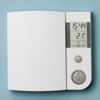 2. Set the Timer: Instead of manually adjusting your heating and cooling system each day, use a programmable thermostat that you can set and forget. A smart thermostat can automatically adjust the temperature based on your restaurant’s operating hours. With heating and cooling accounting for the majority of your utility bill, there’s a lot of savings to be had from efficiently controlling your restaurant’s climate.
2. Set the Timer: Instead of manually adjusting your heating and cooling system each day, use a programmable thermostat that you can set and forget. A smart thermostat can automatically adjust the temperature based on your restaurant’s operating hours. With heating and cooling accounting for the majority of your utility bill, there’s a lot of savings to be had from efficiently controlling your restaurant’s climate. 3. Place an Order for Shade: Speaking of climate control, what are you doing about that midday glare? Professionally-installed window film can block up to 99% of the sun’s rays, naturally keeping your restaurant cooler and customers more comfortable without turning up the A/C. And no matter what time of day, customers won’t need to squint, making it easier for them to enjoy their dining experience.
3. Place an Order for Shade: Speaking of climate control, what are you doing about that midday glare? Professionally-installed window film can block up to 99% of the sun’s rays, naturally keeping your restaurant cooler and customers more comfortable without turning up the A/C. And no matter what time of day, customers won’t need to squint, making it easier for them to enjoy their dining experience.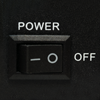 4. Cut the Power: Chances are you leave appliances on even when they aren’t being used. Power down ovens, toasters, and even cash registers when you don’t need them. If you have refrigerators or freezers that consistently remain half-full, condense all the food into fewer units and shut off these under-utilized energy-eaters.
4. Cut the Power: Chances are you leave appliances on even when they aren’t being used. Power down ovens, toasters, and even cash registers when you don’t need them. If you have refrigerators or freezers that consistently remain half-full, condense all the food into fewer units and shut off these under-utilized energy-eaters.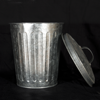 5. Take Out the Trash: Whether it’s an extra refrigerator you’ve been holding on to, a mediocre exhaust hood or a 10-year-old dishwasher, you likely have at least one large, energy-draining item that needs to be thrown out. If it’s a necessary appliance or ventilation system, be sure to replace the old unit with an ENERGY STAR certified version. A good example would be replacing an outdated dishwasher with an insulated or infrared gas model for optimum energy savings.
5. Take Out the Trash: Whether it’s an extra refrigerator you’ve been holding on to, a mediocre exhaust hood or a 10-year-old dishwasher, you likely have at least one large, energy-draining item that needs to be thrown out. If it’s a necessary appliance or ventilation system, be sure to replace the old unit with an ENERGY STAR certified version. A good example would be replacing an outdated dishwasher with an insulated or infrared gas model for optimum energy savings. When your refrigerator hits the just-right proportion of 75 percent full, your stored foods team up with your refrigerator in a really cool way. The foodstuff, cooled to a low temperature, actually helps maintain the chilly ecosystem of the fridge when the door is opened and warm air rushes in. But be careful! Overstuffing limits air circulation, causing the unit to work with less efficiency.
When your refrigerator hits the just-right proportion of 75 percent full, your stored foods team up with your refrigerator in a really cool way. The foodstuff, cooled to a low temperature, actually helps maintain the chilly ecosystem of the fridge when the door is opened and warm air rushes in. But be careful! Overstuffing limits air circulation, causing the unit to work with less efficiency. Most refrigerators should be set between 37 and 40 degrees in the main section, and 0 to 5 degrees in the freezer. If you keep your food too warm, you can lose the cooling effect described in tip #1. If you cool your food too much, you are losing out on energy efficiency. In order to increase your refrigerator’s efficiency, check your owner’s manual to be sure these settings are appropriate for your unit.
Most refrigerators should be set between 37 and 40 degrees in the main section, and 0 to 5 degrees in the freezer. If you keep your food too warm, you can lose the cooling effect described in tip #1. If you cool your food too much, you are losing out on energy efficiency. In order to increase your refrigerator’s efficiency, check your owner’s manual to be sure these settings are appropriate for your unit. Experts say that at least twice a year you should unplug your unit briefly to rid the condenser coils of dust. Once the unit is unplugged, use a long brush or the crevice attachment on your vacuum cleaner. If the condenser coils aren’t cleaned, the buildup of dust can keep heat from being dispelled and cause your unit to overheat.
Experts say that at least twice a year you should unplug your unit briefly to rid the condenser coils of dust. Once the unit is unplugged, use a long brush or the crevice attachment on your vacuum cleaner. If the condenser coils aren’t cleaned, the buildup of dust can keep heat from being dispelled and cause your unit to overheat.